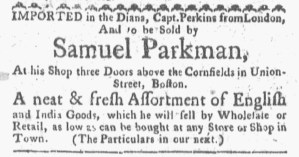What was advertised in a colonial American newspaper 250 years ago today?

“Printed Catalogues may be had at the Auction-Room.”
In the summer of 1772, Joseph Russell, the proprietor of the “Auction-Room in Queen street” in Boston,” advertised a sale of a “very Large and Valuable Collection of BOOKS, in almost every Branch of polite Literature” scheduled for July 17. In anticipation of the auction, he offered “Printed Catalogues” for customers to peruse and mark. Some historians of the book have suggested that many catalogs mentioned in newspaper advertisements never existed. Some booksellers and auctioneers may have promised catalogs as a means of increasing foot traffic, achieving their goal whether or not they passed out any catalogs to anyone who visited their shops or auction halls. Others may have had the best intentions of supplying catalogs, but lack of time or lack of resources worked against them.
Revisions to Russell’s advertisement as the day of the auction approached suggest that he did indeed distribute catalogs. In an advertisement in the July 6 edition of the Boston-Evening Post July 9 edition of the Massachusetts Gazette and Boston Weekly News-Letter, Russell informed the public that “Printed Catalogues may be had at the Auction-Room in Queen-street, the Monday preceding the Time of Sale.” On Monday, July 13, the Boston Evening-Post ran the same advertisement again, but a new advertisement in the Massachusetts Gazette and Boston Post-Boy stated that “Printed Catalogues may be had at the Auction-Room in Queen-street.” A few days later, the advertisement in the Massachusetts Gazette and Boston Weekly News-Letter featured some new copy. Instead of opening with “On Friday 17th July,” the new headline proclaimed “TO-MORROW.” Russell also removed reference to “the Monday preceding the Time of Sale,” asserting that “Printed Catalogues may be had at the Auction-Room in Queen-street.” That brought his advertisement in line with the one recently placed in the Massachusetts Gazette and Post-Boy. Even though Russell neglected to update the advertisement in the Boston Evening-Post, he altered the notice in the Massachusetts Gazette and Boston Weekly News-Letter, suggesting that he sought to bring it into conformity with new developments.


